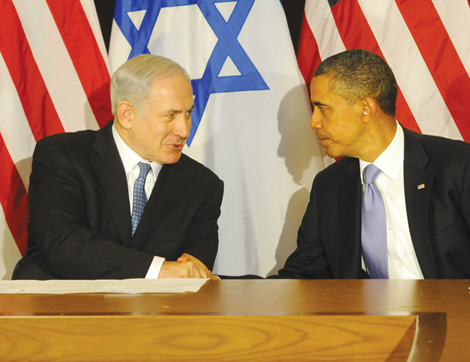
By Keith Johnson –
A Sept. 23 report by Newsweek journalist Eli Lake reveals that Barack Obama secretly approved the transfer of 55 high-tech bunkerbusting bombs to Israel during the early days of his administration. Although this disclosure should come as no surprise, it does demonstrate that tensions between Obama and the Israeli government are nowhere near as bad as some claim, and that military cooperation between the two countries is as strong as it’s ever been.
Lake’s latest piece raises more questions than it answers. Particularly, why did the U.S. shroud this latest deal in such secrecy when previous transfers of the same weapon were transacted conspicuously?
The bombs identified by Lake are GBU-28 hard target penetrators— deadly projectiles that can be launched from Israel’s F-15 fighter jets and are capable of destroying heavily fortified targets beneath 100 feet of earth or 20 feet of concrete. They were initially deployed by the U.S. for Operation Desert Storm, but used more extensively in the Battle of Tora Bora on caves during the bombardment of Afghanistan and western Pakistan in 2001 and 2002.
Delivery of at least some of those weapons was confirmed in July 26, 2006 when The Telegraph reported: “Britain has been used as a staging post for major shipments of bunker-busting bombs from America to Israel. The Israelis want the 5,000-pound smart bombs to attack the bunkers being used by Hezbollah leaders in Lebanon.”
The article went on to cite defense sources who confirmed: “Two chartered Airbus A310 cargo planes filled with GBU 28 laser-guided bombs landed at Prestwick Airport, near Glasgow, for refueling and crew rests after flying across the Atlantic.”
Since the transactions were conducted in such secrecy, some are wondering whether Obama had actually approved delivery of a new, more advanced bomb that exceeds that weapon’s capabilities?
A nuclear variant of the GBU-28 is the B61-11, which can also be deployed from Israel’s existing delivery systems, and—according to the June 1997 edition of Bulletin of the Atomic Scientists—is capable of “destroying the deepest and most hardened of underground bunkers, which the conventional warheads are not capable of doing.”
In an April 6, 2006 article for The New Yorker, Seymour Hersh reported that the Pentagon presented plans to the Bush White House for the deployment of the B61-11 to strike Iran’s underground nuclear facilities at Natanz.
There is no doubt that Israel would love to get its hands on such a weapon, though they would not be able to negotiate openly for its procurement. Israel is not a signatory to the Nuclear Non-Proliferation Treaty and keeps its nuclear arsenal largely under wraps. Any deal would have to be transacted in the strictest confidence, as would the delivery of such a weapon.
So far, neither Newsweek nor any other source has nailed down exactly when the delivery of bombs to Israel occurred. However, one clue is contained in a November 2009 U.S. cable released by Wikileaks, which reads, “The transfer should be handled quietly to avoid any allegations that the U.S. government is helping Israel prepare for a strike against Iran.”
Four months later, on March 15, 2010, The Scotland Herald reported: “Hundreds of powerful U.S. bunkerbuster bombs are being shipped from California to the British island of Diego Garcia in the Indian Ocean in preparation for a possible attack on Iran.”
It’s reasonable to speculate that the shipment contained munitions that were later transported from this transfer point to Israel via ship or submarine. It would have also been an ideal time to do so. Just days earlier, Vice President Joe Biden had been in Israel urging Israeli Prime Minister Benjamin Netanyahu to cease construction of illegal settlements in Jerusalem, and the world perceived that the relationship between the two nations was at an all-time low.
